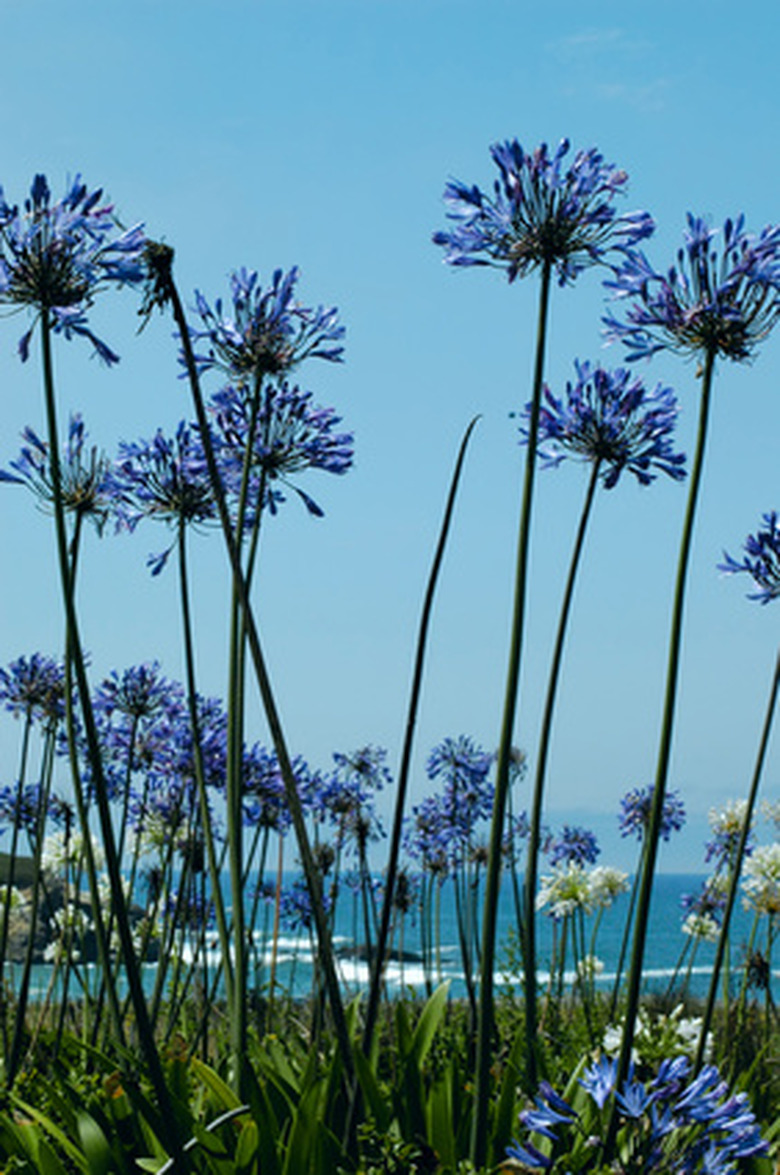The Meaning Of An Agapanthus
Plant taxonomists used to consider agapanthus a member of the Alliaceae or allium family. Now it has been placed in its own family, aptly named Agapanthaceae. No matter where it fits in the botanical scheme, agapanthus is an ornamental plant best known for its rounded umbels of blue, blue-purple or white tubular flowers. Agapanthus is native to South Africa, though it has become naturalized in parts of California and Florida in the United States, as well the Isles of Scilly in the United Kingdom and the Portuguese island of Madeira. The plant has many meanings, depending its medicinal, linguistic or ornamental heritage.
The Meaning of the Name
The genus name, "Agapanthus" is derived from two Greek words: "agape." which means "love," and "anthos," which means "flower". Taken together, the agapanthus is the flower of love. It is sometimes also known as "African lily" and "lily of the Nile," tributes to its African origins.
- Plant taxonomists used to consider agapanthus a member of the Alliaceae or allium family.
- No matter where it fits in the botanical scheme, agapanthus is an ornamental plant best known for its rounded umbels of blue, blue-purple or white tubular flowers.
Medicinal Meaning
Parts of the agapanthus plant are sometimes used for medicinal purposes. In South Africa and elsewhere, its roots are boiled in water to produce a tonic for pregnant women. The tonic is also used to promote contractions during labor. Expectant mothers sometimes wear charms made from the dried roots to ensure healthy babies. While the agapanthus root in any form may mean "healthy baby," the sap contains substances that can irritate skin or mucous membranes.
Meaning According to the Language of Flowers
Since ancient times flowers been assigned "secret" meanings and used to convey feelings that could not be expressed more directly. The practice has a long history in China and eventually spread to the Middle East. The "Language of Flowers" was first introduced to Europe in the early 1700s by Charles II of Sweden, who had been exiled to Turkey for several years, and Lady Mary Wortley Montagu, wife of a British diplomat, who observed the use of flower symbolism while stationed with her husband in Constantinople. One hundred years later, Queen Victoria became enthused about the Language of Flowers, and the practice of including specific flowers in bouquets to convey specific meanings caught on throughout the British Empire and the Western world. In the traditional language of flowers, agapanthus meant "love letter."
- Parts of the agapanthus plant are sometimes used for medicinal purposes.
- In South Africa and elsewhere, its roots are boiled in water to produce a tonic for pregnant women.
Agapanthus in the Garden
To gardeners, the word "agapanthus" signifies a tall, blue-flowered plant that grows from a fleshy rhizome and can reach a height of up to 60 inches. Many varieties feature flower heads that soar high about the strap-like leaves, which are also somewhat fire-resistant. Individual specimens are most effective when massed in a flower border or in containers. In cold winter climates, the containerized specimens must be brought indoors during the late fall and winter months.
Varieties
Breeders have developed many new agapanthus hybrids over the last 10 to 15 years, developing traits that include larger flower heads, color variations and increased cold tolerance. The most popular are hybrids of the South African native, Agapanthus praecox. As with many other tall plants, breeders have also sought to produced dwarf specimens with the same large flowers as taller varieties, but shorter stems. Dwarf specimens generally range from nine to 20 inches tall and may have blue or white flowers.
- To gardeners, the word "agapanthus" signifies a tall, blue-flowered plant that grows from a fleshy rhizome and can reach a height of up to 60 inches.
- Many varieties feature flower heads that soar high about the strap-like leaves, which are also somewhat fire-resistant.
References
- "Medical Toxicology of Natural Substances: Foods, Fungi, Medicinal Herbs, Plants and Venimous Animals"; Donald G. Barceloux; 2008
- North Carolina State University: Plant Fact Sheets: Agapanthus
- Merriam Webster's Online Dictionary: Agapanthus
- "The Botanical Garden"; Roger Phillips and Martyn Rix; 2002
